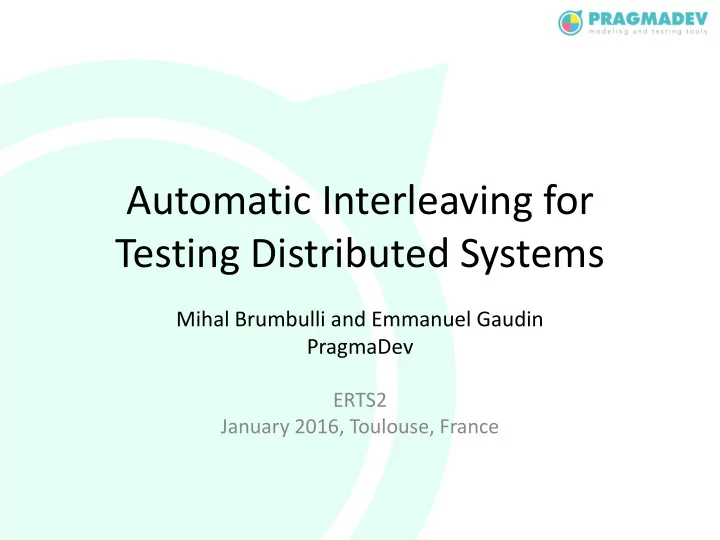

Automatic Interleaving for Testing Distributed Systems Mihal Brumbulli and Emmanuel Gaudin PragmaDev ERTS2 January 2016, Toulouse, France
Introduction • Constant ever-growing interest for large-scale distributed systems – The Internet of Things interconnects billions of smart objects • Complex applications due to heterogeneity and distribution scale – Testing is not a trivial task
Motivation • Operation of nodes is not isolated – Test cases must account for the distribution and interaction between nodes • Existing test cases have to be adapted to consider distribution – Introduce concurrency handling into test cases (need to modify existing test cases) – Controlled concurrent execution that deals with all relevant interleavings (need to control execution, e.g., scheduler)
Specification and Description Language (ITU-T) Unified Modeling Language (OMG) Testing and Test Control Notation Version 3 (ETSI) TECHNOLOGY
Structure & Behavior
Deployment & Test
What are the effects of distributed execution of test cases? Rewrite the test cases or execute them in parallel? Can we simulate parallelism efficiently? INTERLEAVING
Problem Concurrent execution of 𝑳 test cases • with 𝒐 𝒋 instructions for 𝒋 = 𝟐 , 𝟑 , … 𝑳 – the number of all interleavings is – 𝑳 ∑ 𝒐 𝒋 ! 𝒋=𝟐 𝑱 = 𝑳 ∏ 𝒐 𝒋 ! 𝒋=𝟐 Concurrent execution of 𝑳 instances of the same test case • with 𝒐 𝒋 = 𝑶 ∀𝒋 instructions – the number of all interleavings is – 𝑱 = 𝑳𝑶 ! 𝑶 ! 𝑳 Typical case of the state-explosion problem which makes execution of all • interleavings unpractical. However, …
Solution • Not all interleavings are relevant – Distribution may affect behavior only if there is an interaction between nodes – If the execution of a test case does not involve any interaction, then distribution will not have any impact • Interleave execution at critical points – instructions that trigger interaction between nodes
Algorithm Group the instructions and then interleave execution of the groups • Each group must include at most one instruction which triggers • interaction 𝟐 𝟏 , 𝒏 𝟑 𝟐 , 𝒏 𝟒 𝟏 , 𝒏 𝟓 𝟐 , 𝒏 𝟔 𝟐 , 𝒏 𝟕 𝟏 , 𝒏 𝟖 𝟐 , 𝒏 𝟗 𝟏 , 𝒏 𝟘 𝟏 , 𝒏 𝟐𝟏 𝒏 𝟐 𝒉 𝟐 𝒉 𝟑 𝒉 𝟒 𝒉 𝟓 𝒉 𝟔 𝒌 is an instruction in the test case 𝒏 𝒋 • – 𝒋 = 𝟐 , 𝟑 , … 𝑶 is the index (relative order) of the instruction, – 𝒌 = 𝟏 , 𝟐 if the given instruction triggers (or not) any interaction 𝒌 for which ∑ 𝒌 ≤ 𝟐 A group consists of all subsequent 𝒏 𝒋 •
Normal mode: execute test case and mark instructions that trigger interaction based on the deployment diagram Interleaving mode: automatically generate and execute all interleavings SIMULATION
PragmaDev Co-Simulator
Example • Access system has terminals and a central unit – Terminal has a slot for the card and a keypad for the key – Central unit checks whether access should be granted to a user • A user can be either administrator or normal
Example • Test case: try to get in and out of administrator mode – 1 interleaving point; 2 groups – 2 terminals; 6 interleavings to execute – not much to expect, however… – one terminal blocked indefinitely waiting for a reply from the central unit! • Other 4 problems with the system were identified in the same way
Conclusions • The algorithm may not always produce significantly less interleavings – Degree of interaction between nodes – High degree is more an exception than the rule • Successful application of the approach with a simple example – Working on more complex systems • The approach is based on simulation – Cannot be applied (at present) for test cases on real target
Questions? THANK YOU!
Recommend
More recommend